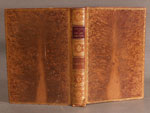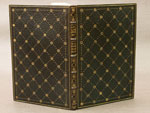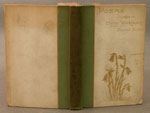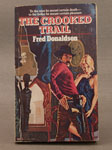History of Binding
Introduction to the Exhibit
The book in the codex form, or the book as we know it today, has been around for nearly 2000 years. But the books we read today look nothing like those early books bound by the Copts and early Christians. This exhibit offers examples of bindings from throughout the ages, beginning with some of the oldest books in the collection, from the 15th century. Each page shows a different era of binding and how the styles have changed through the centuries. Some mention of structure is here and there, but the focus is on the style and the materials used.
Dating a bookbinding can be difficult. Unlike the printing, a binding can be changed, altered, removed and rebound at any point in time. Some of the books in this exhibit do not have their original bindings or have been repaired; these changes have been noted when known. Other bindings may look like an earlier style, but be more modern than they look. Whatever the case, these books will show how the bindings of books have changed over time and offer an appreciation and celebration of the book as physical object.
- Author:
- Scott, Walter, Sir, 1771-1832
- Title:
- The lay of the last minstrel.
- Publisher:
- Boston : Ticknor and company, 1887.
- Call Number:
- PR 5309 .A1 1887b
- Author:
- Morris, William, 1834-1896.
- Title:
- An address delivered by William Morris at the distribution of prizes to students of the Birmingham Municipal School of Art, on Feb. 21, 1894.
- Publisher:
- Boston : [London, Longmans & Co., 1898]
- Call Number:
- PR5080 .A3.
- Author:
- Dickinson, Emily, 1830-1886.
- Title:
- Poems by Emily Dickinson, ed. by two of her friends, T. W. Higginson and Mabel Loomis Todd. 2d series.
- Publisher:
- Boston, Roberts brothers, 1892.
- Call Number:
- PS1541 .P62 1892.
- Author:
- Donaldson, Fred.
- Title:
- The crooked trail.
- Publisher:
- New York : Dorchester Pub. Co., 1983.
- Call Number:
- PS3554.O468 C766 1983.




